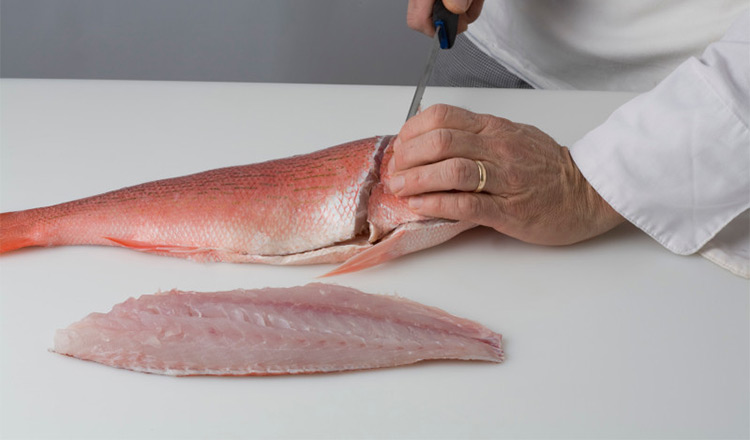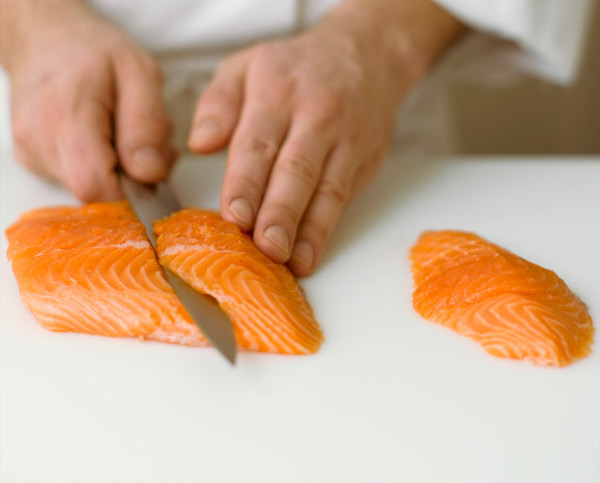Before you can even think about cooking fish, you have to buy it (well, or catch it, if that’s your thing!), and buying fish can be challenging. Is it fresh? Is it the right kind of fish for what you want to make? Where does it come from, and does it matter?
The first step in the selection process is assessing the purveyor or market. The fishmonger should properly handle, ice, and display the fish and should be able to answer any questions regarding the fish’s origin and its qualities: lean or oily, firm-textured or delicate, appropriate for moist-heat method or able to withstand a grill’s heat.
Market Forms of Fish
Fish can be purchased fresh in the market forms described below, as well as in frozen, smoked, pickled, or salted forms.
Whole fish: This is the fish as it was caught, completely intact. This is typically referred to as “in the round.”
Drawn fish: The viscera (guts) are removed, but head, fins, and scales are still intact.
H & G (headed and gutted) or head-off drawn: The head and viscera (guts) are removed, but scales and fins are still intact.
Dressed fish: The viscera (guts), gills, scales, and fins are removed. The head may or may not be removed. Also known as pan-dressed, these fish are usually appropriate for a single serving.
Steak: This is a portion-sized cross section cut from a dressed fish. Portion cuts from the fillets of large fish, such as tuna and swordfish, are also commonly called steaks.
Fillet: This is a boneless piece of fish, removed from either side of the backbone. The skin may or may not be removed before cooking. Purveyors often sell fillets “pin-bone in,” so it is important to specify “pin-bone out” when ordering.

Tranche: A portion-sized slice of a fillet that is cut at a 45-degree angle to expose a greater surface area. A tranche is generally cut from a large fillet, for example, salmon or halibut.

Pavé: A portion-sized square cut from a fillet. A pavé is generally cut from a large fillet, for example, salmon, halibut, mahi mahi, or tuna.
Freshness Checks for Finfish
To ensure that fish are of the best quality, carefully inspect them, checking for as many of the following signs of freshness and quality as possible:
- Fish should be stored at a temperature of 40°F or less. Displayed fish will generally be packed in ice or in a clean, refrigerated case. While you may not have access to this particular data point, it is helpful to keep in mind as you assess your surroundings.

- The fish should have a good overall appearance (clear slime, no cuts or bruising, pliable fins).
- The scales should adhere tightly to the fish.
- The flesh should respond to light pressure and not feel soft. Don’t be afraid to inspect the fish or ask for a closer look.
- The eyes should be clear, bright, and bulging.

- The gills should be bright pink to maroon in color, and if mucous is present, it should be clear.
- There should be no “belly burn”—evidence that the viscera (guts) were left in the fish too long, resulting in bacteria and enzymes breaking down the flesh along the rib cage.
- The fish should have a clean, sweet, sea-like smell.
Sustainability
As cooks and food lovers, we have a responsibility, to the best of our abilities, to seek ingredients that are produced and sourced by sustainable means. In the conversation about ethical and environmentally friendly food, there is an enormous effort to prevent overfishing of vulnerable species and encourage consumers to explore new varieties. Availability of fish is dependent on location, season, and weather, so we like looking to organizations like Seafood Watch. They offer detailed information and recommendations so you can make educated choices on the go.


